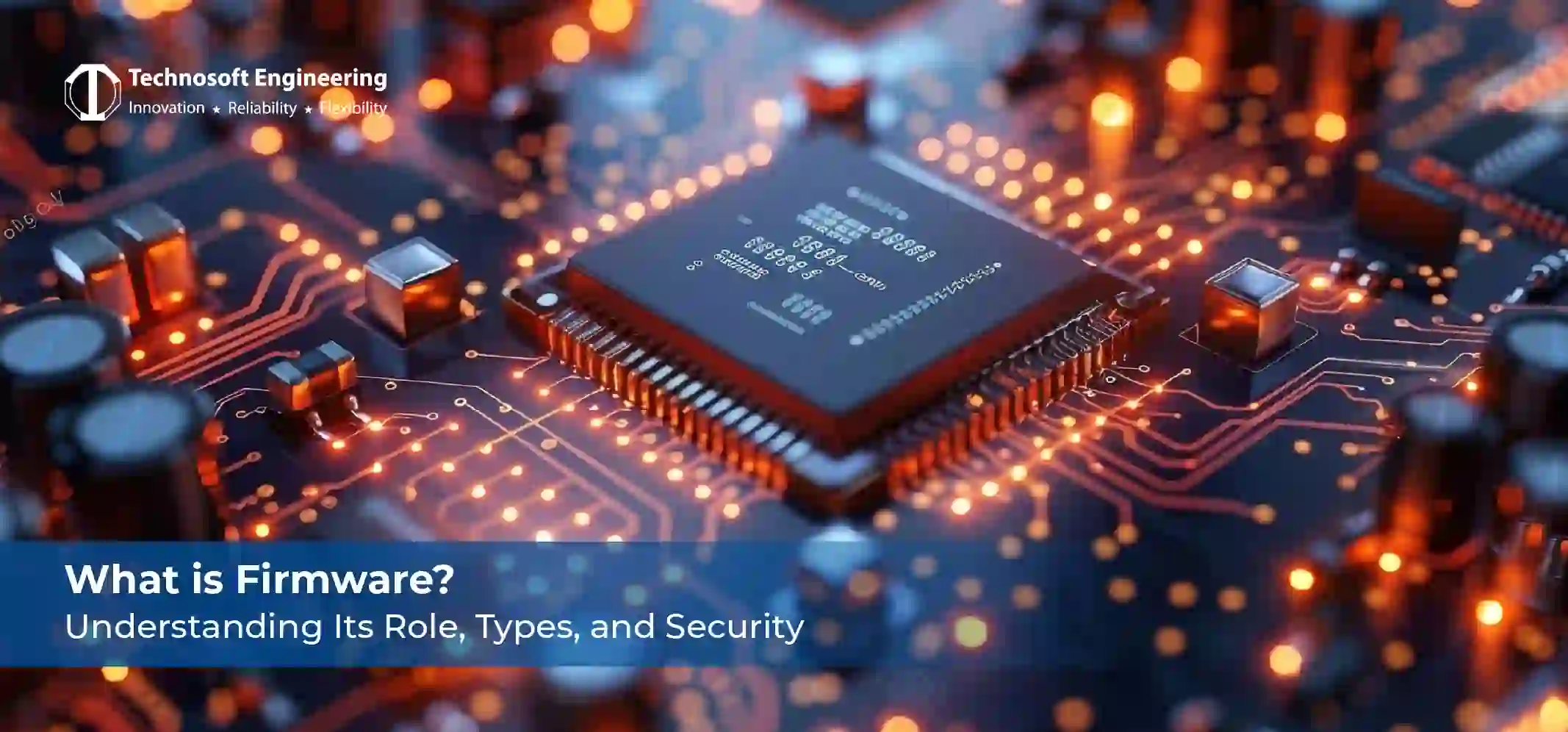
In the world of complete digital devices, one common term that keeps coming up is firmware. They are commonly found in smartphones, laptops, and industrial systems. They are everywhere, but what exactly is it?
This blog is going to answer all the essential questions you are looking for, such as “What is firmware?”
We’ll also talk about what firmware is in computer systems, the types of firmware, firmware security, and the key difference between firmware and software.
We will also discuss how the firmware works and guide you through specific vital processes, such as the firmware development process and available firmware development services.
What is Firmware?
In simple terms, firmware is a class of computer software that offers low-level control for a device’s specific hardware. It is embedded in the hardware, like a microchip, and operates to make sure the hardware system functions properly. Unlike application software that perfectly interacts with users, firmware is an essential part of operation, even when it cannot be seen. It lies between the hardware and software of a device, which enables both to work in synergy.
What is Firmware in Computer Systems?
When we talk about what firmware is in computer systems, we’re referring to the code embedded in hardware parts, such as BIOS (Basic Input Output System), hard drives, and graphics cards. You can locate the firmware on the computer when:
- Initializing hardware during the boot process
- Offers the instructions required for the OS for interacting with the hardware
- Can be updated (firmware upgrade) to fix bugs or to improve performance
A good example is the BIOS firmware, which is the first software that works when you power on your PC. It first checks all hardware components and loads the operating system into memory.
Types of Firmware
You will find different types of firmware, categorized based on their functionality and the devices they operate in:
- BIOS/UEFI Firmware – Used in computers to initialize hardware and load the OS.
- Embedded Firmware – Found in devices like microwaves, routers, and smartwatches.
- Peripheral Firmware – Used in accessories like printers, mice, and keyboards.
- Network Firmware – Enables connectivity and communication in devices such as routers and switches.
- Security Firmware – Added layers of firmware for safety and protection in sensitive environments.
- Every type plays a crucial role in ensuring the reliability, operations, and longevity of the device.
What is Firmware Security?
As the number of devices connected is growing, firmware has become the best choice for cyberattacks. Since firmware is known to operate at such a low level, old antivirus programs are usually unable to detect firmware-based threats.
Firmware security includes:
- Protecting firmware from illegal modifications
- Ensuring secure updates of the firmware
- Check vulnerability assessments often
- Implementing secure boot protocols
For big companies and organizations, maintaining firmware security is essential for protecting intellectual property and preventing unauthorized access to their devices.
Difference Between Firmware and Software
Let’s clarify the difference between firmware and software — a common point of confusion.
Feature Firmware Software
Location Embedded in hardware, Installed on OS
Function Controls hardware performs user tasks
Updates: Less frequent, frequently updated
Interaction: No user interface. Has a user interface
Volatility : Non-volatile Stored in volatile or non-volatile memory
This means that firmware is a subtype of software that is tightly associated with hardware. Regular software, like web browsers or word processors, is known to work on top of the OS and can be easily changed or removed.
How Does Firmware Work?
Do you wonder how firmware works? Firmware is stored in non-volatile memory like ROM, EPROM, or flash memory. It starts with the hardware parts and makes sure that a higher level of software can communicate properly with physical components.
Here’s how the process works out:
- When the device turns on, the firmware runs first.
- It immediately performs first to ensure all hardware parts are working.
- It then begins communication with the OS and the hardware.
- The system then becomes completely functional only after the firmware completes the entire task.
This invisible control is the reason why several home appliances and devices can function independently.
Firmware vs Hardware
You can often see confusion about firmware vs hardware. Hardware is the physical machine, whereas firmware is the code that instructs the machine, which is the hardware on how to work.
Firmware Development Process
Knowing the Firmware Development Process is essential for businesses building new products. It also includes:
- Requirements gathering
- Hardware abstraction
- Code development
- Testing and debugging
- Validation
- Deployment
- Ongoing updates and maintenance
This whole process makes sure that the firmware is integrated perfectly with the hardware and performs very well.
Firmware Development Services
If you are in search of building an innovative tech product, professional Firmware Development Services could be an excellent start for you. Technosoft provides end-to-end firmware design, development, and maintenance services for all our customers in electronics, automotive, healthcare, and IoT industries.
Conclusion
I hope we successfully made clear what firmware is, now you know that it plays an indispensable role in the operations and the security of the modern devices. From determining what is firmware in computer systems to understanding types of firmware and ensuring firmware security, this component is the backbone of digital hardware.
Whether you are a tech enthusiast or a business innovating new devices, understanding firmware will help you stay ahead in today’s times.
Looking to Build Smarter Devices?
Explore how Technosoft’s Firmware Development solutions can help transform your product idea into reality. Whether you’re in need of embedded systems, secure firmware, or full-stack IoT development, we’ve got you covered. Contact us today.